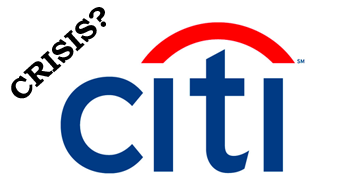Is Citigroup on the Precipice of Disaster?

Mega Banks
Written by Ophir Gottlieb, 10-29-2015Follow @OphirGottlieb
The main stream media, and often times Wall St. as well, will lump the mega banks in the US into one group. They are wrong. It turns out that they couldn't be more different.
The Risk Story
There are two charts to this article, but I won't delay the satisfaction. As promised, there is an enormous risk here that harkens back to the days of the financial crisis of 2008.
We write one story a day to uncover new opportunities and break news. Get Our (Free) News Alerts Once a Day.
OK... What's the Crisis?
It turns out the banks classify assets and liabilities on their balance sheets as either level 1, level 2 or level 3. It's the level 3 assets and liabilities which haven't traded in so long that there is no observable price. So, for example, imagine typing in a stock ticker and the stock hasn't traded in a year, so there is no price. The only problem is, banks must report all assets and liabilities. So what's a bank to do?
The banks make an educated guess to the value of these non observed liabilities (and assets) using some proprietary model that they have created. That's why these tricky things are often times called "mark-to-model." Let's look at an astounding chart that plots the percent of total liabilities that are marked as level 3 on the y-axis and then on the x-axis we'll look at the raw value of level 3 liabilities. This is for the largest five banks in the United States.
Thrive on understanding what's really going on in a company beyond headlines? Get Our (Free) News Alerts Once a Day.
We find an impossible result. Look at the upper right hand corner. Fully 18% of Citigroup's liabilities are marked as level 3 (unobservable). Is that high? It's CRAZY high.
USB, BAC, JPM and WFC report between 0.04% and 3% of their liabilities as level 3.
Give Me Some Hard Numbers
Citigroup "claims" nearly $300 billion in these unobservable liabilities (again, that's a number they made up). The most any other bank reports is WFC at $48 billion. Friends, we live in a world where about $1 out of every $5 that Citigroup reports as liability is essentially made up. Could it be bigger? Sure it could, that's Citigroup's reported number, and no one else's.
New to This Site?
Get free news alerts (once a day) from us just like this. You will be the expert in the room.
Another Story: What About the other Mega banks?
It turns out, these mega banks are wildly different in the way they do business and that means they are wildly different stocks to own. Do you want to bet on consumer's paying their loans back? How about real estate? In the image below, we have plotted Real Estate Loans as percentage of Total Loans on the y-axis, and Consumer Loans as a percentage of Total Loans on the x-axis.
Provided by CMLviz.com
It takes more than click bait and a 140 characters to be an expert and Wall St. doesn't have the vocabulary or incentive to report on financial institutions and breaking technology. Get free news alerts (once a day) from us and you will be the expert in the room. You will be powerful.
What did we find?
Wells Fargo (WFC) has massive real estate exposure relative to the other majors, with more than half of its money ($0.51 out of every dollar loaned) out to real estate borrowers and only $0.14 out of every dollar going to consumer loans.
JPM is the polar opposite. Just $0.01 out of every dollar it lends goes out to real estate loans, while $0.55 out of every dollar goes out to consumer loans.
BAC is the most evenly mixed: $0.30 out of every dollar it lends goes to the consumer borrowers and $0.27 out of every dollar it lends goes to real estate borrowers.
New to This Site? Get News Notifications; Be The Expert in the Room.
The media simply isn't equipped to understand the stock market beyond headlines. Try CML Pro. No credit Card. No Payment Info. Just the Power.
Now You Know
When a news article pops by or a Wall St. analyst speaks up and lumps the big four into one monolith, you know, they're wrong; and you know exactly why.
Join Us: Get News Notifications; Be The Expert in the Room.


